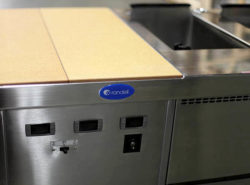 Sous-vide (pronounced sue-veed), or cooking “under vacuum,” is more popular than ever in today’s professional kitchens. Still, this technique seems to be greatly misunderstood. The process involves a vacuum-sealed bag filled with a single order of some protein, like salmon or filet mignon. The protein cooks slowly for several hours in a water bath to produce some of the best-tasting bites of joy you have ever had!
Sous-vide (pronounced sue-veed), or cooking “under vacuum,” is more popular than ever in today’s professional kitchens. Still, this technique seems to be greatly misunderstood. The process involves a vacuum-sealed bag filled with a single order of some protein, like salmon or filet mignon. The protein cooks slowly for several hours in a water bath to produce some of the best-tasting bites of joy you have ever had!
The intent of this article is not to teach you how to become a sous-vide master. Rather, I want to share an invaluable foodservice opportunity with you, as well as a powerful solution to help you navigate the modern culinary world successfully.
As the makers of Groen’s CapKold Cook-Chill System, we have been a market segment leader in the large-scale processing of food under vacuum for decades. Therefore, we understand the importance of process with this effective technique.
When I visit a commercial kitchen, I often see a sous-vide immersion circulator sitting on a back table. That’s the precision temperature cooking device that is used to manage water temperature to an accuracy of a tenth of a degree. Floating around in the circulator will be some kind of bucket of water with 20-30 bags of single orders of fish, duck or steak. This always makes me think to myself, “Did they follow the rules?”
Do they even know what the rules are?
Sous-vide is more of a science than an art, and there are more rules than I can explain in a single blog post. Here are some basic guidelines for proper sous-vide preparation:
In a traditional commercial kitchen environment, most of these things are simply not happening! When is the last time you have been in a 64°F kitchen? Cutting boards are at room temperature at best, which is above 80°F in most kitchens I have worked in. Just during the time it takes to bag up 20 orders of fish you can easily see a 10+ degree temperature jump.
There has been no real solution for chefs in the past, but those days are over, thanks to the Randell FX Series sous-vide prep table!
This unit packs a whole lot of problem solving into a small 30″ x 40″ footprint. For starters, the entire prep table is built on top of the Randell FX Series precision refrigeration drawer unit that has a 2°F variance in temperature. Storing proteins at 32°F is the best way to slow bacterial growth and maintain the freshest product without freezing.
Also, no other commercial refrigerator offers cold control from -4°F to 40°F, and the refrigerated worktop with removable cutting boards delivers cold on contact. This keeps the food colder as you work and creates a colder zone directly around the working area.
Finally, a built-in hot well with temperature assistance prevents “thermal shock” to the water bath when the chef introduces the 20+ bags of food. This prevents a drop in the water temperature that could create an unsafe environment for the packaged foods.
The FX sous vide prep table provides a dedicated, specialized work area that facilitates best practices in sous vide cooking. Are you one of the many chefs around the country who already use sous vide as a regular cooking technique? Please share what you prepare below!
Steve D’Angelo
Electrolux Professional Group Corporate Chef
[email protected]